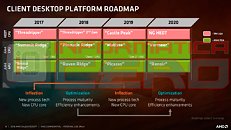Friday, March 9th 2018

AMD Product Roadmap Slides for 2020 Leaked - "Castle Peak" TR4 and "Dali"
Continuing with its trend of leaking AMD slides, Spanish website Informatica Cero has now published some purported company slides leading up to AMD's 2020 strategy. New information concerns the appearance of a new, value-oriented mobile APU in the form of "Dali" - let's hope performance on that is slightly more predictable than the particular style of the artist whose name it follows. Dali therefore joins AMD's "Renoir" APU and "Vermeer" CPUs (both expected in the 7 nm process) for AMD's 2020 roadmap. This is an interesting product, which AMD is likely positioning for tablets and ultraportables.
Another interesting tidbit is AMD's outlook for their Threadripper line of HEDT CPUs. The company is looking towards its 7 nm rendition of these powerhouse chips, codenamed "Castle Peak", to bring them, in a literal way, to that figurative peak. AMD compares Threadripper to a Monster Truck of computing, and is apparently hoping to introduce Castle Peak as early as 2019. AMD then plans to further refine these "process inflection point" products in a new generation to come right after, in 2020 (much like the company has done now with Zen and Zen+).AMD expects these CPUs to bring them towards a "leadership position in the HEDT market", with new "high water marks in performance and efficiency" and new platform features that "take TR to the next level." AMD has certainly earned a lot of goodwill from customers - and the overall market, if you discount Dell - on the back of its Zen-powered products. here's hoping they can continue their winning streak and deliver even more impressive products.
Source:
Informatica Cero
Another interesting tidbit is AMD's outlook for their Threadripper line of HEDT CPUs. The company is looking towards its 7 nm rendition of these powerhouse chips, codenamed "Castle Peak", to bring them, in a literal way, to that figurative peak. AMD compares Threadripper to a Monster Truck of computing, and is apparently hoping to introduce Castle Peak as early as 2019. AMD then plans to further refine these "process inflection point" products in a new generation to come right after, in 2020 (much like the company has done now with Zen and Zen+).AMD expects these CPUs to bring them towards a "leadership position in the HEDT market", with new "high water marks in performance and efficiency" and new platform features that "take TR to the next level." AMD has certainly earned a lot of goodwill from customers - and the overall market, if you discount Dell - on the back of its Zen-powered products. here's hoping they can continue their winning streak and deliver even more impressive products.



42 Comments on AMD Product Roadmap Slides for 2020 Leaked - "Castle Peak" TR4 and "Dali"
However, seeing the new Zen leaks and clocks it is clear as day that AMD is making bigger steps at this time. Much needed steps, but the raw % performance increase per release/gen is significant. Still, I would have jumped on Ryzen if it went to 4.5 Ghz and this still seems out of reach, if only by a little, and the OC capabilities are simply not there, let's be honest. 4 Ghz median clock between all parts really is low, and the new releases aren't really changing that all too much, 4.1 ~ 4.2 Ghz seems the new norm for the next round, with 4.35 best-case.
Ironically TR is capable of holding the higher clocks with many core configurations better than Intel's line up, but Intel can still peak higher. Zen is more/too 'rigid' while Intel's core is extremely versatile.
'The people'... how much history lesson do you need? AMD went through half a decade of bad CPU sales because of 'the people' who bought Intel due to precisely its more versatile nature, higher single threaded performance and wide range of configurations to suit every form factor and market segment.
Ironically even the completely unrelated bench results you linked show how 'rigid' Ryzen CPUs are in terms of performance: the low variation in clockspeeds shows a very small performance min/max between Ryzen 5 and 7. Only 3.2K points gained for 2c/4t extra, because they clock low, again underlining how much more versatile Intel's lineup is, taking both the bottom and top ends of that chart.
You know what they say... love makes blind. This is not a stab at AMD, it is positive to see the strides they're making but let's just keep it real.
The Zen architecture is a great architecture on paper, it really shows that it has the room to scale higher whereas Intel's Nehalem architecture from which all current generation processors can trace back their lineage is starting to show its age. We can see that in how lately Intel has only been feeding us 10% improvements (or even less) from generation to generation; the architecture is at the end of its life. If Intel has any hopes of doing any better than single-digit performance increases they'll have to go back to the drawing board and design an entirely new architecture from scratch but without any competition from the likes of AMD (up until now) there's been no reason to do so because they've enjoyed a virtual monopoly on processor performance.
Like I said before, the Zen architecture is a great architecture on paper; you can see that in what it's been able to do so far. Unfortunately it's a very young architecture being held back by current lithography processes. You can clearly see that the Zen architecture was made for high clocks from the very beginning, its performance increases quite well as you increase the clock speed. Unfortunately the current lithography process is what holds this architecture back, it can't clock high enough to really show what Zen can do. Hopefully with Zen 2 we'll finally see what the Zen architecture can really do since there's already data to show that GloFlo's 7nm process (along with help from IBM) results in much higher speeds; closer to 5 GHz which is what the Zen architecture so desperately needs. Once the Zen architecture hits 5 GHz is when we'll finally see what Zen can really do and I have a good feeling that that's when Zen will take off like a rocket leaving Intel in the dust.Yes, and it's a wonder what AMD has been able to do with the Zen architecture. It's a great architecture on paper with more than enough room to scale, I said this above but as I also said above that current process nodes holds this architecture back big time. This architecture loves high clocks!
On topic: With 7nm Ryzen, i am going back to camp AMD afer a long long time.
Ryzen 1/2K are both great chips and Zen+ has been an excellent refresh. The 8700K still has both IPC and clock advantages, there's no other way of skinning that cat. AMD is getting dangerously close and I think they're gonna leap-frog Intel with Zen2 on 7nm but reality is reality.
You're just shitting on Intel and propping up AMD just to do so because you seem to be a huge AMD fan. That's not cool. This is coming from someone who happens to be wearing an AMD t-shirt, has built multiple Ryzen and EPYC rigs but still keeps an 8700K in my main gaming PC.
Thought processes / trains of thought like yours offering nothing of value / don't help our community /cause. Especially the AMD sub-comm, we get a bad rap because of shit like this. Try and take a step back and look at how you approached this and you're thought process(es) here.
Cheers man!